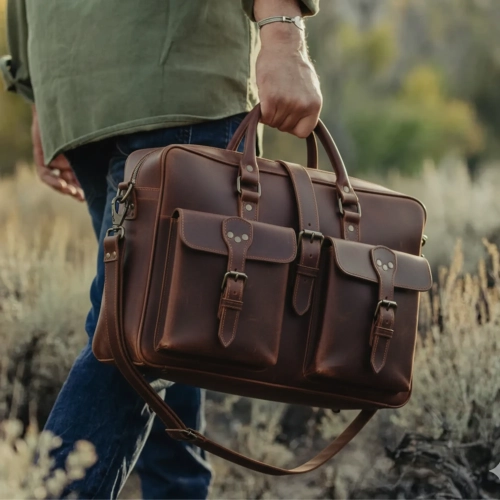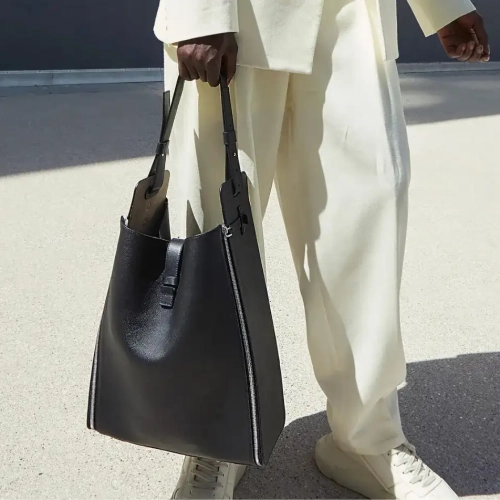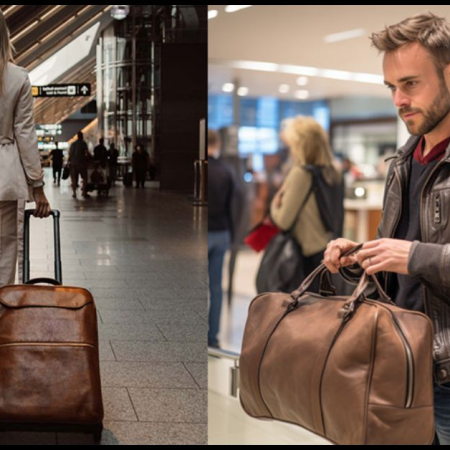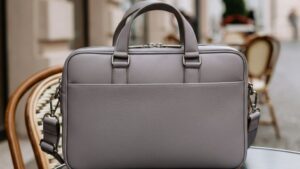No products in the cart.
Return To Shop
0
$0.00
0
No products in the cart.
Return To Shop
Shopping cart (0)
Subtotal: $0.00
Free shipping over 49$
0
$0.00
0
No products in the cart.
Return To Shop
Shopping cart (0)
Subtotal: $0.00
Free shipping over 49$
FREE SHIPPING+30 DAY RETURNS
Order Now - 3 Buyers Get 100% Order Value Back Daily
0
$0.00
0
No products in the cart.
Return To Shop
Shopping cart (0)
Subtotal: $0.00
Free shipping over 49$
If you travel by air often, you know packing isn’t always simple. The query mostly comes down to understanding the difference between a carry-on and a personal item and how it affects your journey. With so many luggage choices, figuring out whether to bring a carry-on or a personal bag can be tricky. Many travelers face the carry-on and how big can a personal item be dilemma before every trip. In this guide, we’ll break down the key points of carry-on vs personal items, explain the pros of each, and share useful tips so you can make the right choice for your next flight.
Carry-On vs Personal Item: Understanding the Differences
The world has so many airline companies, thus, the rules concerning baggage may vary across the world. Some will only just accept one and some will allow you to take both the bag with your personal items and one carry-on bag. There is a typical question that most travelers have when it comes to the major distinction between carry-on baggage and personal item and how a checked bag fits in all these?
In this guide, we’ll break down personal item vs carry-on vs. checked bag and get to know what is a carry-on bag so you know exactly what each means. We’ll also explain the difference between carry-on and a checked bag and how a personal bag for travel can make your journey more convenient. By the end, you’ll clearly understand checked bag vs carry-on vs personal item, along with the benefits of each, plus useful tips for picking the right option for your next trip.
What is a Carry-On Bag?
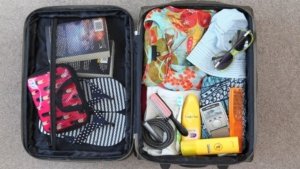
You might be thinking what is considered a carry-on bag, for that you should imagine that it is either of the two purses that you are normally licensed to carry to the cabin of the aircraft. What is a carry-on-bag? The meaning of carry-on bag is the luggage that can be carried on the plane with approval of the airline regulations since it fits within the allowed size and as such can be stashed in the overhead container.
The carry-on bag is characterized by suicidal suitcases, large bags and even some duffel bags. In case you are wondering what is the size of a carry-on, most airlines accept dimensions that are almost what the size of a carry-on is, roughly, 22 inches in height, 14 inches in width and 9 inches in depth. The carry-on luggage meaning also includes remembering to measure from the base to the top, counting wheels and handles. For many travelers, what is a full-size carry-on bag is one that reaches these maximum limits.
Did you ever notice how does a carry-on bag look like? It is typically a compact yet roomy piece of luggage, part of what is carry-on baggage, designed to carry your travel essentials without being checked in.
What Is a Personal Item?
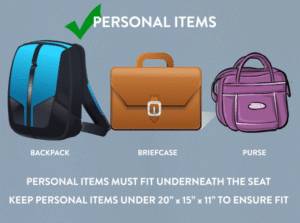
A personal travel bag is usually smaller and designed to fix under the plane seat in front of you, which is why most rolling suitcases won’t qualify. If you’re wondering what a personal item on a plane is and thinking “does a purse count as a carry on”, then yes, it often includes things like a big purse, laptop carry bag, small pet carrier, or other items of same size.
Since airline rules are different, always check with your carrier to avoid surprises at boarding. If the bag is too large, you might have to pay for a carry-on instead. As a rough estimate, general guideline is to regard as personal item on a plane whatever is less than 9 x 10 x 17 inches. Keeping your personal items within these limits will save you time, money, and hassle.
Understanding The Basics
Size and Shape
When traveling, understanding the difference in carry-on personal item size can save you trouble at the gate. Most of the airline organizations offer an airline bag dimension rule, which fits easily inside the bin and measures 22 inches wide and 9 inches thick. The services of different airlines on the items that an individual can carry on board may vary in different airlines although the allowances are ruled to fit into specified storage bags.
A personal item would be lesser in size and more likely to assume a two-way orientation such as a handbag, a small backpack or briefcase it must be those which are sandwiched between the seat in front of you. Their normal size is about 18 inches by 15 inches and 8 inches respectively. The airlines also impose a limit to the weight limit although its biggest disadvantage is size.
Reading up your airlines regulations beforehand allows you to have an easier time on your journey without any last minute rush.
Accessibility During the Flight
Since your personal item remains easily accessible throughout the flight as it is stored under the seat in front of you. You can reach for anything you need without having to stand up, open the overhead bin, or dig through your suitcase during the trip.
Allowed Items
What you can bring and where it’s kept are two ways that a carry-on and a personal item differ from one another. Airlines give restrictions around carry-on bags because it is often going to fit up overhead of the plane.
Items that are flammable, explosive, or sharp tools cannot be packed. There is a need to have liquids, gels, sprays packed in transparent quart size bags and other liquid products in containers not greater than 3.4 ounces (100 milliliters). This includes such items as beverages, toiletries and make-up. Other sporting items which can be used, such as golf clubs, skis, snowboards should be specially packs as carry-ons or be checked as oversized luggage.
Also, the airlines do not accept extra products in the form of carry-ons that are excessive both in weight and size but should be packed either differently or with oversized bags. The size and weight limits that are imposed to carry a row by the airlines are also subject to this where by in case your baggage has turned out to be of large size and weight of course there may be the need of checking the luggage or rather there may be an extra amount added.
The smaller size personal items, which comprise: a purse, laptop bag, small backpack or the camera bag may be left on the floor of the seat in front of you. Many airlines also let you bring a few extra things, such as snacks, a jacket, an umbrella, or a small care kit with things like toothpaste, a toothbrush, or face wipes.
Guide on Airline Rules and Bag Size Restrictions
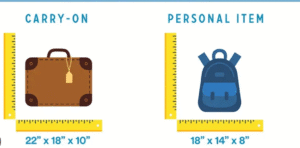
That is not all, it is quite significant to know Airline rules and regulation that is to not have a cliffhanger situation at the last moment. Every airline has a different set of rules regarding personal item vs carry-on bag sizes, so it’s good to be well informed. It will help you to avoid excessive airports stress and additional costs. The following are some of the airlines policies:
Major Airlines’ Policies
United Airlines
United airlines also permits one carry-on bag for free, with maximum dimensions of 9x14x22. If you are wondering, “Is this backpack a carry-on?” It can be, provided it meets this size limit. You may also take one personal item measuring no more than 9x10x17, which could be a purse, small backpack, or laptop bag. In everyday terms, people sometimes ask, “Is a book bag considered a carry-on?” For United, it’s a personal item if it fits under the seat, but a carry-on if it needs to go overhead.
All the specific and current instructions are worth consulting the official page of each airline, which provides clear information on the baggage policy prior to a trip.
American Airlines
When taking an American Airlines flight, you may take a carry-on bag and one personal item on board. The personal carry-on size for items like a backpack, purse, or laptop bag should not be more than 18 x 14 x 8 inches (45 x 35 x 20 cm) so it can fit under the seat in front of you. Many travelers ask, “Is a backpack a personal item or is a backpack a carry-on? yes, it usually is, but certain items such as diaper bags (one per child), breast pumps, small soft coolers for breast milk, strollers, child safety seats, and medical or mobility devices are not counted as personal items.
American Airlines allows a carry-on bag with a total size of 22 x 14 x 9 inches (56 x 36 x 23 cm), including handles and wheels. This to them is cabin baggage. In case it does not fit the overhead bin it should be checked in.
Delta Airlines
Delta Airline allows a single free carry-on which may be a roll-aboard, duffle bag and any other luggage of similar size. Most of the passengers who use a purse are usually faced with a question that runs as follows; “Does a purse count as a carry-on or a personal item? Well, it depends on the size. Just as long as it can fit overhead and its less than 22 x 14 x 9 inches then it qualifies as carry-on. Besides, the passenger is also permitted to hold one personal item that is free of charge, such as purse, book bag, or laptop bag as it can fit under the seat.
Items You Can’t Pack in Personal Bags or Carry-Ons

Carry-on bags and personal items are related to specific packing rules when taken on a flight.
While the TSA offers a full , here are some of the most common things you can’t bring on board:
- Any form of explosives
- Flammable things
- Sharp tools and objects
- Firearms or weapon-like items
- Liquids or gels over 3.4oz (100 ml) anything exceeding this limit will be taken and disposed of by airport security
- Some kind of sports gear, such as golf clubs, snowboards, tennis racquets, and skis. Airlines often have separate policies for sports equipment, so it’s best to check directly with them for exact guidelines.
Top Travel Tips for Frequent Flyers

Pack Light and Smart
Bring what you need the most. Use both your carry-on bag and personal item to organize your things in a better and more organized way and avoid checking bags.
Know Your Airline’s Rules
Always read the size and weight limits for carry-on bags and personal items before packing, as rules are different for each airline.
Keep Important Items Handy
Put important things like your passport, wallet, phone, and snacks in your personal items so you can get easy access to them during the flight.
Use TSA-Approved Bags for Liquids
Ensure that any liquids, gels, or sprays you carry are in proper containers of 3.4 ounces or less, and pack them in a transparent bag for a rapid security check.
Charge Your Devices Before Flying
You should charge your phone, laptop or any other electronics you are carrying before the plane takes off, as not all planes have power sockets.
Wear Comfortable Clothes
Wear comfortable shoes and clothes to make your travel experience easier and better, especially when you are having a long flight.
Arrive Early to the Airport
Always get to the airport early, as it helps avoid last-minute hassle and gives you space to handle luggage, security, and boarding without panicking.
Tips to Prevent Oversize and Overweight Baggage Charges
Some air traveling companies charge additional costs on oversized or overweight luggage. As such, one should consider thoroughly examining the luggage policies of your carrier beforehand to evade such expenses, particularly with a low-cost carrier. Most carriers let you bring a personal item for free, but they often have strict limits on size and weight. If your bag is too big or too heavy, you could be charged $50 or more at the check-in counter. The same rules apply to carry-on luggage.
Should You Travel with a Carry-On, a Personal Item, or Both?

When selecting between a carry-on bag and personal item for your tour, think about some important points.
- First, you should know how long you’ll be traveling. For a short trip, you can usually fit all your things into a carry-on bag and personal item without needing to have big luggage. Where you need to carry larger baggage is in the case of longer journeys.
- Secondly, you should know what you’re bringing. A large carry-on luggage would be good to carry along fragile items, such as electronics so that they are not broken and are accessible.
- Also, consider the weight you’re willing to carry. Smaller carry-on bag and personal item might be the best option; in case you choose to go across the light to the airport.
- Lastly, always know your airline’s baggage policy. This helps you follow their size and weight limits and avoid sudden fees at the gate.
Final Thoughts on Carry-On Vs Personal Item for Smarter Travel
Selecting between a carry-on bag and a personal item doesn’t have to be difficult. The best choice depends on your trip duration, the things you need to have, and how you want to travel. For quick trips, both a carry-on bag and personal item can be enough to pack clothes, toiletries, and a few extras without checking luggage. For longer trips, or if you have bulky items, a bigger suitcase might be important.
Personal item is ideal because you can carry your necessities, e.g. passport, wallet, and phone in it easily within reach (during the flight). You can have more clothes, more shoes, and bigger items in a carry-on bag but you will not be charged a fee because of the baggage.
It is best to ask what the size and weigh regulation is in your airline, then pack. This way, you can make the most out of your carry-on bag and personal item, travel lighter, save money, and avoid any last-minute stress at the airport.
Frequently Asked Questions (FAQs)
What is a carry-on bag vs personal item?
A carry-on bag is larger and they should be kept in the overhead bin whereas Personal item is smaller and can fit under your seat.
What is a carry-on vs personal item?
A checked bag would be placed in the cargo hold in the plane; a carry-on is slightly bigger and goes overhead; a checked bag is stored in the plane’s cargo hold.
What is a carry-on bag vs personal item?
Most airlines allow a personal item up to around 16 x 12 x 6 inches, but always check your airline’s rules.
What is a personal item vs carry-on?
A small backpack usually counts as a personal item if it fits under the seat; a large one may be considered a carry-on bag.
What to pack in a carry-on vs personal item?
A carry-on bag is a piece of luggage small enough to fit in the overhead bin, meeting your airline’s size limits.
john
I’m John, co-founder of Levant Leather and a passionate expert in premium leather. With nearly a decade in the luxury leather industry, I’ve gained deep experience as both a designer and manufacturer through my work at Levant Leather
Author Posts 
